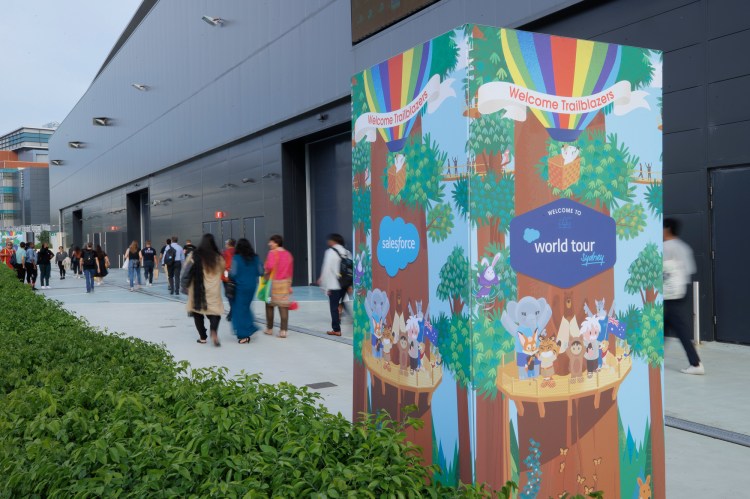At the end of last year, Good Return’s Head of Fundraising Cathy Sowden joined Salesforce SVP and General Manager, Financial Services Rohit Mahna live on the Dreamforce stage to take Good Return’s story to an international audience. Just before Sowden took to the stage, we caught up in the APAC on Tour lounge for a chat.
“I feel like I have the best job in the world,” Sowden says, when we ask her how she describes her work at Good Return to her friends.
“I sit between interesting people who are generous and who care, and I help them to funnel their good fortune into creating a level playing field for people who are trying really hard but just have some disadvantages. That is a fantastic place to be.”
Those generous, interesting people are on track to hitting a major milestone – funding $1 million worth of microloans to women entrepreneurs across the Asia Pacific region. Through our supporters over 50,000 women have been able to start businesses in their local communities that support their families, improve those communities, and change their own lives.
“The money initially goes to entrepreneurs – and we have a repayment rate of 99.7% from those loans,” Sowden explains. “Once it is repaid, 80% of our supporters decide to continue to invest, so that money is then on-lent or is diverted into our programs – five women can do a financial education program using the donated proceeds from one loan.”
Q: What’s next for Good Return?
Over the past six months, we’ve been focused on pre-launch for a new program, the Impact Investing program, which will expand the social enterprise’s remit to provide larger loans to fund employment within the communities of our entrepreneurs.
We’ve recruited an Impact Investing team. They’ve conducted scoping trips to Indonesia, Cambodia and PNG, among others to identify SMEs or social enterprises that are going really well and would like to expand to take on new staff or farmers in their local communities, but are not able to access traditional business finance.
The reasons for that inability to access finance might include lack of collateral, lack of paperwork, lack of relationships.
Of course, we’re also continuing to grow our micro-loans as well. We increased our fundraising revenue by 46% this year, and we’ll do the same next year.
Q: That’s enviable growth for any financial services company or social enterprise. How have you achieved it?
We’ve been improving our communications and our engagement with our donors.
We have a better view of the segments we work with and a better view of where they are in their relationship with us, so we’re able to be more responsive to them as donors and to communicate the impact their generosity has had on our beneficiaries more effectively. And that’s leading to increased value of gifts and increased donor retention.
Q: You’ve spent 20 years ‘doing’ in purpose-led organisations, can you tell me about some of the changes you’ve seen in two decades?
I’ve seen so many changes. In the past, corporate social responsibility was the purview of one or two members of the C-suite, who’d make a decision and write the cheque. Now a relationship between a corporate and an NFP is multifactorial. It can and should affect all the stakeholders of the corporate; it can be a business tool or an employee loyalty tool or a marketing tool.
The NFP sector too has changed – we now understand the importance of collaboration with the communities we’re supporting, and the importance, rather than just giving a donation, of giving purpose and leaving beneficiaries with long-term change so they have the power to improve their own lives and communities.
So for example, the idea of Good Return is to provide loans so that people can create their own long-term income, and there is an education part of that mission as well. In a place like Cambodia there is a lack of understanding of savings, bank accounts. Financial education just hasn’t come through the schooling system in the same way it has in Australia. A lot of the people we work with live in very remote communities where there are no banks, and we are just trying to teach them the things that we take for granted, like how to protect themselves against over indebtedness and avoid exploitation.
Q: What changes do you see on the horizon?
One inevitable change that is going to continue across the sector is the impact of technology. We’ve always done face-to-face training with our beneficiaries, and now we still do face-to-face training with our most vulnerable clients, but we achieve impact by converting that face-to-face training to digital training.
We co-created an app with Accenture, My Money Tracker, which is a digital version of face-to-face training. It makes it easy for someone who lives and works in a cash economy to record and track cash flow on a daily basis and view monthly trends, understand whether their business is making a profit or a loss, and gain a simple view of credit and debt.
We also use Salesforce to connect our lenders with our businesses, and we use our eLearning tool to train banks and other financial services providers in client protection principles. Embracing technology has allowed us to benefit more than 2 million people to date.
Anyone can download that app, but we have customised it for Cambodia in this instance and then we will create versions for Philippines and Nepal, because we do need to take into account local ways of operating.
A really exciting potential development for us is bringing our programs to Australia – we’ve been having conversations about trying to bring a digital financial training tool to help Indigenous women and vulnerable young people.
In an environment of stagnant wages with an increasing threat from payday lending and credit card debt, we see young people getting into financial trouble because they don’t have the tools to understand that it’s happening to them.
The need is definitely there but we would need to localise and customise our programs to suit what those communities actually need and what they don’t need, so we can be of benefit to them and they aren’t exploited.
Localisation is key – it’s a question of respect. You can’t go into somebody’s community and just assume, ‘That works for me so it will work for you’. A combination of localisation and digitalisation means we can impact whole communities, one at a time.
Q: What is the impact of that technological change on trust?
People test donations, and Good Return loans are a form of donation – they are trying to see how responsible we are with their money, so demonstrating the impact that their donation has had builds trust. By communicating with them, by being responsive to their needs, we gain their trust.
The practical impact of gaining that trust is reinvestment. Just over 80% of our investors then reinvest when the loan is repaid – and I think this is very strongly correlated with demonstrating impact.
The platforms also make it simple for new investors to find and support us. We ran a corporate giving campaign that aimed to fund loans for 30 women in 30 days, and one of the employees that supported us said that her daughter loved the idea so much that she donated all her bat mitzvah money.
She went on the website and she found the woman she wanted to donate to. And the beauty is that the loan platform gives that direct connectedness. So this 12-year-old girl in Australia could see a woman who could change her life and her children’s lives with $500, and she was able to make a decision, with her parents, to support this woman.
The chances are that the woman would pay the money back – our repayment rate is higher than 99% – and then the girl could either take the money back or it could go to somebody else.
The technology and the mechanism is just about leveling and equalising opportunity, really.
Cathy Sowden is Head of Fundraising at Good Return and has a passion for connecting people who care about the rest of the world with those who need their help. Read more from Cathy.
If you missed Dreamforce, catch up on incredible speakers and amazing discussions on Salesforce Live.























